Business Law Report: Business Structures, Articles, and Alterations
VerifiedAdded on 2020/05/08
|11
|2579
|47
Report
AI Summary
This report provides a comprehensive overview of business law, focusing on the types of business structures prevalent in Malaysia. It begins by defining and differentiating between sole proprietorships, partnerships, and companies, highlighting their unique features, registration processes, and liabilities. The report then delves into the concept of articles of association, explaining their significance in defining a company's operations, including details about shareholders meetings, share capital, and the company's purpose. Furthermore, it explores the process of altering these articles, referencing relevant sections of the Companies Act 1965 and legal precedents. The report offers valuable insights into the legal framework governing business operations in Malaysia, making it a useful resource for students studying business law.
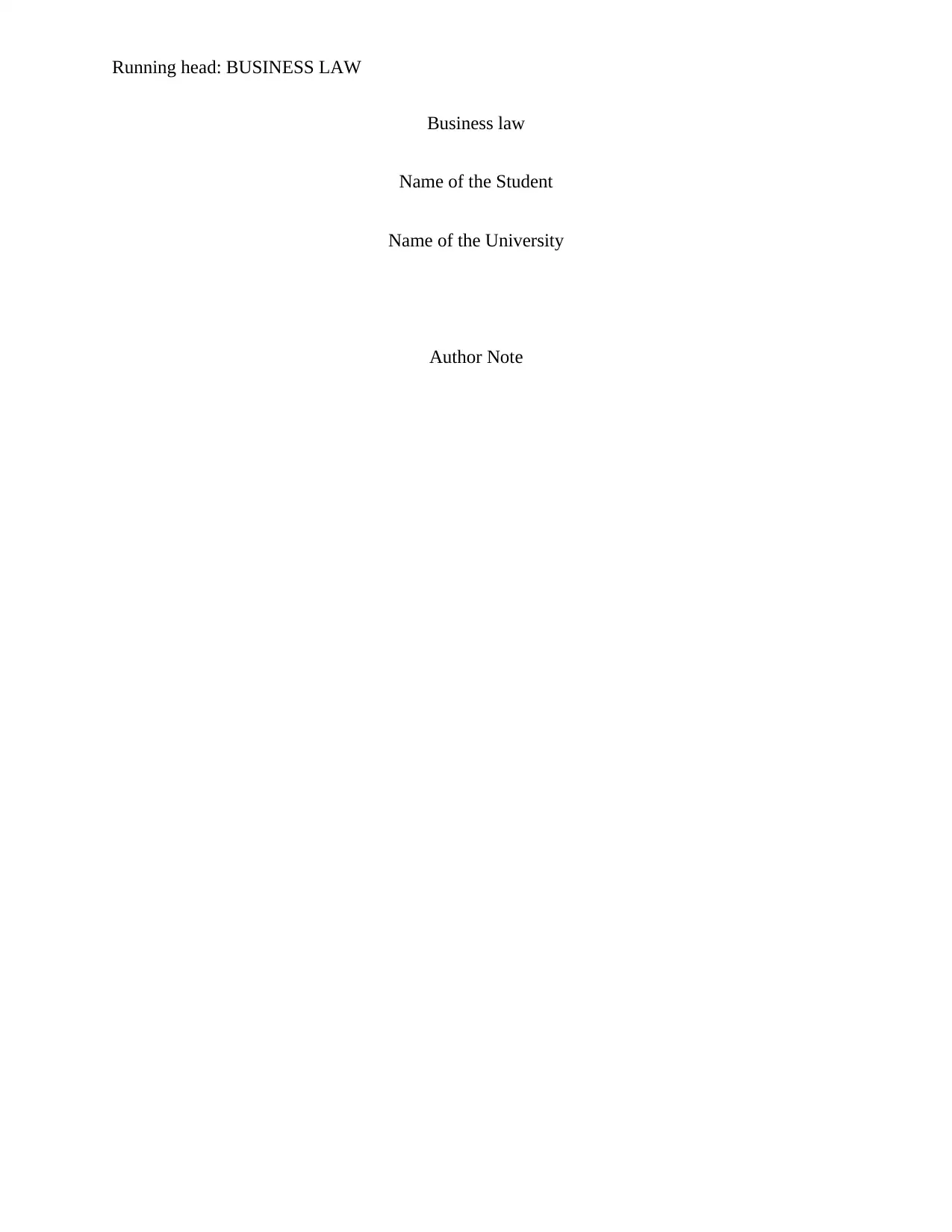
Running head: BUSINESS LAW
Business law
Name of the Student
Name of the University
Author Note
Business law
Name of the Student
Name of the University
Author Note
Paraphrase This Document
Need a fresh take? Get an instant paraphrase of this document with our AI Paraphraser
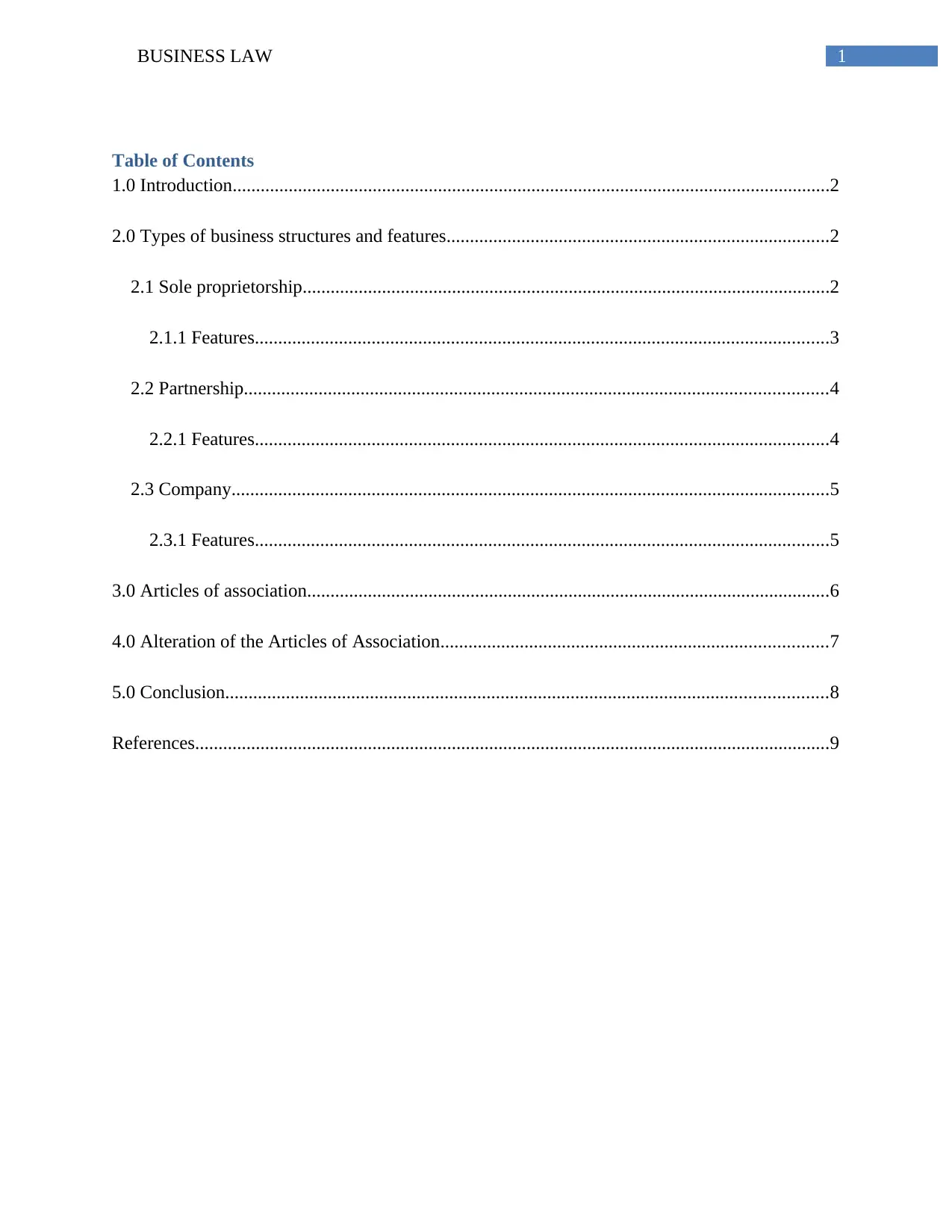
1BUSINESS LAW
Table of Contents
1.0 Introduction................................................................................................................................2
2.0 Types of business structures and features..................................................................................2
2.1 Sole proprietorship.................................................................................................................2
2.1.1 Features...........................................................................................................................3
2.2 Partnership.............................................................................................................................4
2.2.1 Features...........................................................................................................................4
2.3 Company................................................................................................................................5
2.3.1 Features...........................................................................................................................5
3.0 Articles of association................................................................................................................6
4.0 Alteration of the Articles of Association...................................................................................7
5.0 Conclusion.................................................................................................................................8
References........................................................................................................................................9
Table of Contents
1.0 Introduction................................................................................................................................2
2.0 Types of business structures and features..................................................................................2
2.1 Sole proprietorship.................................................................................................................2
2.1.1 Features...........................................................................................................................3
2.2 Partnership.............................................................................................................................4
2.2.1 Features...........................................................................................................................4
2.3 Company................................................................................................................................5
2.3.1 Features...........................................................................................................................5
3.0 Articles of association................................................................................................................6
4.0 Alteration of the Articles of Association...................................................................................7
5.0 Conclusion.................................................................................................................................8
References........................................................................................................................................9
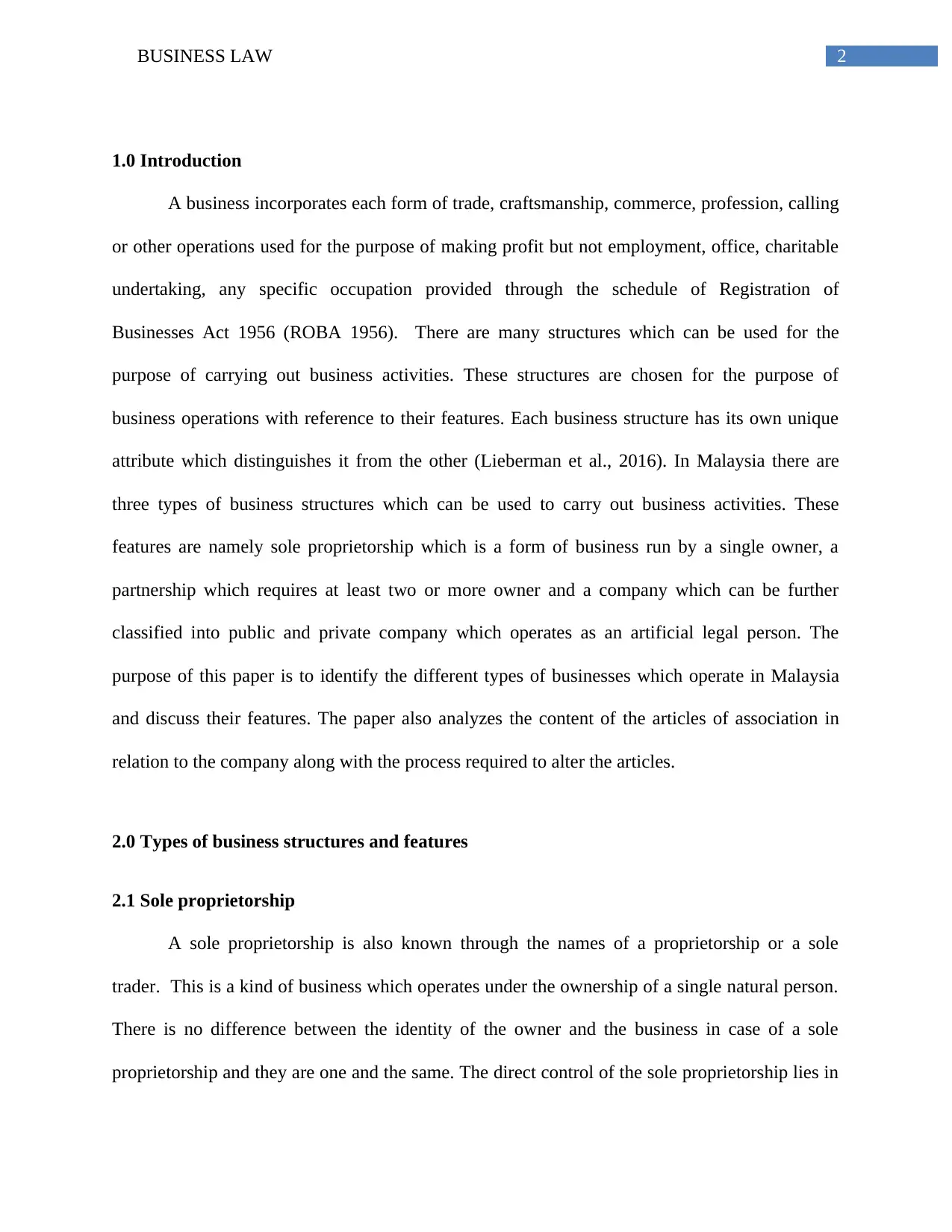
2BUSINESS LAW
1.0 Introduction
A business incorporates each form of trade, craftsmanship, commerce, profession, calling
or other operations used for the purpose of making profit but not employment, office, charitable
undertaking, any specific occupation provided through the schedule of Registration of
Businesses Act 1956 (ROBA 1956). There are many structures which can be used for the
purpose of carrying out business activities. These structures are chosen for the purpose of
business operations with reference to their features. Each business structure has its own unique
attribute which distinguishes it from the other (Lieberman et al., 2016). In Malaysia there are
three types of business structures which can be used to carry out business activities. These
features are namely sole proprietorship which is a form of business run by a single owner, a
partnership which requires at least two or more owner and a company which can be further
classified into public and private company which operates as an artificial legal person. The
purpose of this paper is to identify the different types of businesses which operate in Malaysia
and discuss their features. The paper also analyzes the content of the articles of association in
relation to the company along with the process required to alter the articles.
2.0 Types of business structures and features
2.1 Sole proprietorship
A sole proprietorship is also known through the names of a proprietorship or a sole
trader. This is a kind of business which operates under the ownership of a single natural person.
There is no difference between the identity of the owner and the business in case of a sole
proprietorship and they are one and the same. The direct control of the sole proprietorship lies in
1.0 Introduction
A business incorporates each form of trade, craftsmanship, commerce, profession, calling
or other operations used for the purpose of making profit but not employment, office, charitable
undertaking, any specific occupation provided through the schedule of Registration of
Businesses Act 1956 (ROBA 1956). There are many structures which can be used for the
purpose of carrying out business activities. These structures are chosen for the purpose of
business operations with reference to their features. Each business structure has its own unique
attribute which distinguishes it from the other (Lieberman et al., 2016). In Malaysia there are
three types of business structures which can be used to carry out business activities. These
features are namely sole proprietorship which is a form of business run by a single owner, a
partnership which requires at least two or more owner and a company which can be further
classified into public and private company which operates as an artificial legal person. The
purpose of this paper is to identify the different types of businesses which operate in Malaysia
and discuss their features. The paper also analyzes the content of the articles of association in
relation to the company along with the process required to alter the articles.
2.0 Types of business structures and features
2.1 Sole proprietorship
A sole proprietorship is also known through the names of a proprietorship or a sole
trader. This is a kind of business which operates under the ownership of a single natural person.
There is no difference between the identity of the owner and the business in case of a sole
proprietorship and they are one and the same. The direct control of the sole proprietorship lies in
⊘ This is a preview!⊘
Do you want full access?
Subscribe today to unlock all pages.

Trusted by 1+ million students worldwide
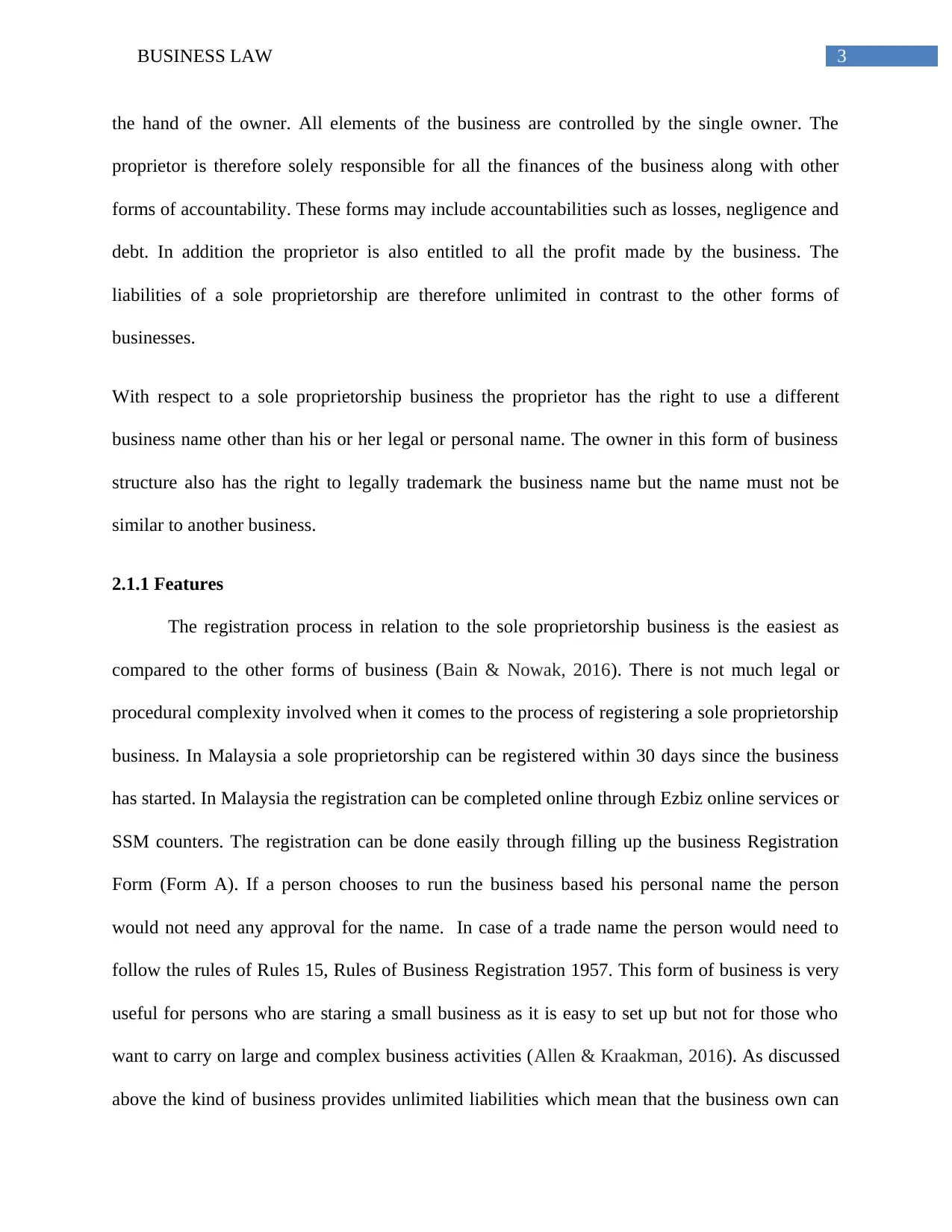
3BUSINESS LAW
the hand of the owner. All elements of the business are controlled by the single owner. The
proprietor is therefore solely responsible for all the finances of the business along with other
forms of accountability. These forms may include accountabilities such as losses, negligence and
debt. In addition the proprietor is also entitled to all the profit made by the business. The
liabilities of a sole proprietorship are therefore unlimited in contrast to the other forms of
businesses.
With respect to a sole proprietorship business the proprietor has the right to use a different
business name other than his or her legal or personal name. The owner in this form of business
structure also has the right to legally trademark the business name but the name must not be
similar to another business.
2.1.1 Features
The registration process in relation to the sole proprietorship business is the easiest as
compared to the other forms of business (Bain & Nowak, 2016). There is not much legal or
procedural complexity involved when it comes to the process of registering a sole proprietorship
business. In Malaysia a sole proprietorship can be registered within 30 days since the business
has started. In Malaysia the registration can be completed online through Ezbiz online services or
SSM counters. The registration can be done easily through filling up the business Registration
Form (Form A). If a person chooses to run the business based his personal name the person
would not need any approval for the name. In case of a trade name the person would need to
follow the rules of Rules 15, Rules of Business Registration 1957. This form of business is very
useful for persons who are staring a small business as it is easy to set up but not for those who
want to carry on large and complex business activities (Allen & Kraakman, 2016). As discussed
above the kind of business provides unlimited liabilities which mean that the business own can
the hand of the owner. All elements of the business are controlled by the single owner. The
proprietor is therefore solely responsible for all the finances of the business along with other
forms of accountability. These forms may include accountabilities such as losses, negligence and
debt. In addition the proprietor is also entitled to all the profit made by the business. The
liabilities of a sole proprietorship are therefore unlimited in contrast to the other forms of
businesses.
With respect to a sole proprietorship business the proprietor has the right to use a different
business name other than his or her legal or personal name. The owner in this form of business
structure also has the right to legally trademark the business name but the name must not be
similar to another business.
2.1.1 Features
The registration process in relation to the sole proprietorship business is the easiest as
compared to the other forms of business (Bain & Nowak, 2016). There is not much legal or
procedural complexity involved when it comes to the process of registering a sole proprietorship
business. In Malaysia a sole proprietorship can be registered within 30 days since the business
has started. In Malaysia the registration can be completed online through Ezbiz online services or
SSM counters. The registration can be done easily through filling up the business Registration
Form (Form A). If a person chooses to run the business based his personal name the person
would not need any approval for the name. In case of a trade name the person would need to
follow the rules of Rules 15, Rules of Business Registration 1957. This form of business is very
useful for persons who are staring a small business as it is easy to set up but not for those who
want to carry on large and complex business activities (Allen & Kraakman, 2016). As discussed
above the kind of business provides unlimited liabilities which mean that the business own can
Paraphrase This Document
Need a fresh take? Get an instant paraphrase of this document with our AI Paraphraser
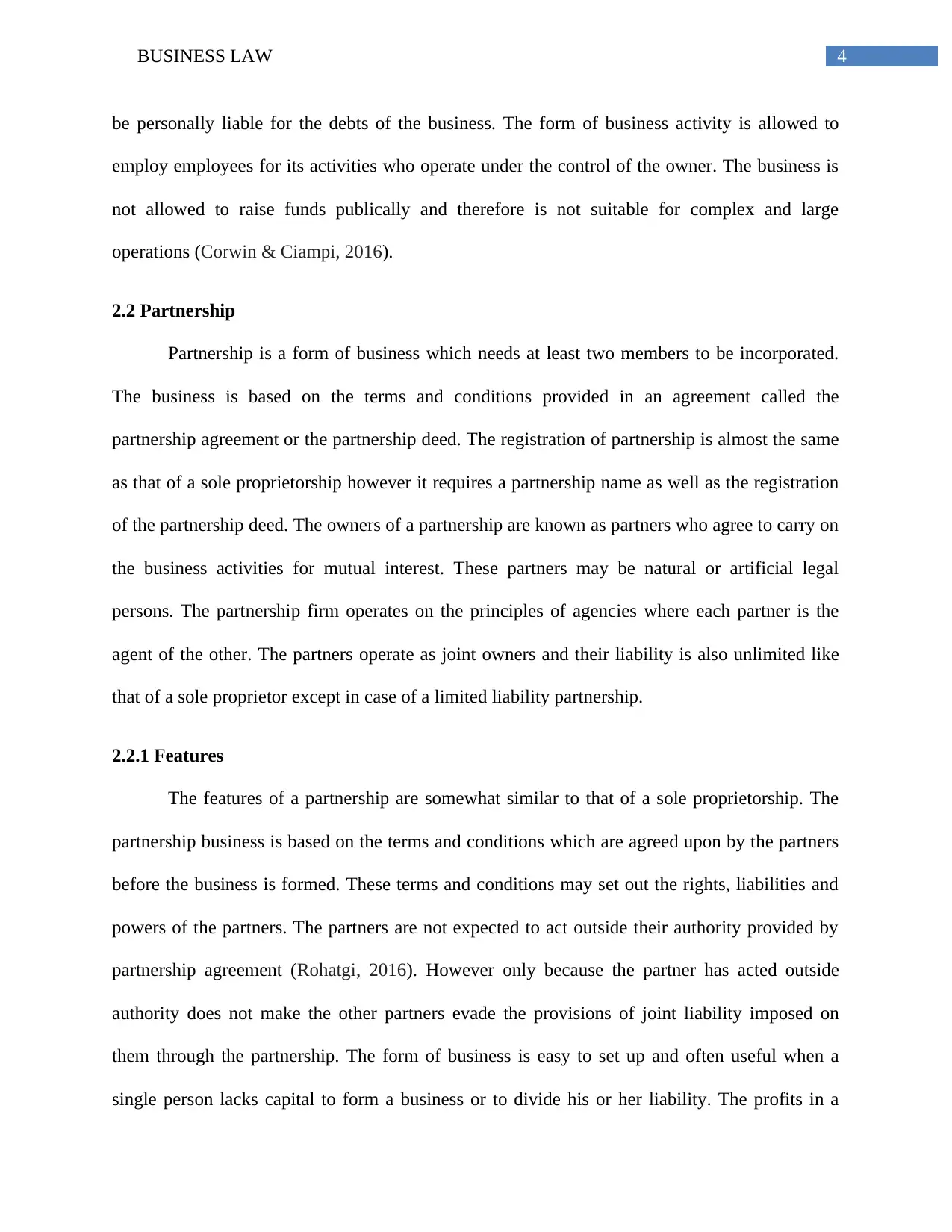
4BUSINESS LAW
be personally liable for the debts of the business. The form of business activity is allowed to
employ employees for its activities who operate under the control of the owner. The business is
not allowed to raise funds publically and therefore is not suitable for complex and large
operations (Corwin & Ciampi, 2016).
2.2 Partnership
Partnership is a form of business which needs at least two members to be incorporated.
The business is based on the terms and conditions provided in an agreement called the
partnership agreement or the partnership deed. The registration of partnership is almost the same
as that of a sole proprietorship however it requires a partnership name as well as the registration
of the partnership deed. The owners of a partnership are known as partners who agree to carry on
the business activities for mutual interest. These partners may be natural or artificial legal
persons. The partnership firm operates on the principles of agencies where each partner is the
agent of the other. The partners operate as joint owners and their liability is also unlimited like
that of a sole proprietor except in case of a limited liability partnership.
2.2.1 Features
The features of a partnership are somewhat similar to that of a sole proprietorship. The
partnership business is based on the terms and conditions which are agreed upon by the partners
before the business is formed. These terms and conditions may set out the rights, liabilities and
powers of the partners. The partners are not expected to act outside their authority provided by
partnership agreement (Rohatgi, 2016). However only because the partner has acted outside
authority does not make the other partners evade the provisions of joint liability imposed on
them through the partnership. The form of business is easy to set up and often useful when a
single person lacks capital to form a business or to divide his or her liability. The profits in a
be personally liable for the debts of the business. The form of business activity is allowed to
employ employees for its activities who operate under the control of the owner. The business is
not allowed to raise funds publically and therefore is not suitable for complex and large
operations (Corwin & Ciampi, 2016).
2.2 Partnership
Partnership is a form of business which needs at least two members to be incorporated.
The business is based on the terms and conditions provided in an agreement called the
partnership agreement or the partnership deed. The registration of partnership is almost the same
as that of a sole proprietorship however it requires a partnership name as well as the registration
of the partnership deed. The owners of a partnership are known as partners who agree to carry on
the business activities for mutual interest. These partners may be natural or artificial legal
persons. The partnership firm operates on the principles of agencies where each partner is the
agent of the other. The partners operate as joint owners and their liability is also unlimited like
that of a sole proprietor except in case of a limited liability partnership.
2.2.1 Features
The features of a partnership are somewhat similar to that of a sole proprietorship. The
partnership business is based on the terms and conditions which are agreed upon by the partners
before the business is formed. These terms and conditions may set out the rights, liabilities and
powers of the partners. The partners are not expected to act outside their authority provided by
partnership agreement (Rohatgi, 2016). However only because the partner has acted outside
authority does not make the other partners evade the provisions of joint liability imposed on
them through the partnership. The form of business is easy to set up and often useful when a
single person lacks capital to form a business or to divide his or her liability. The profits in a
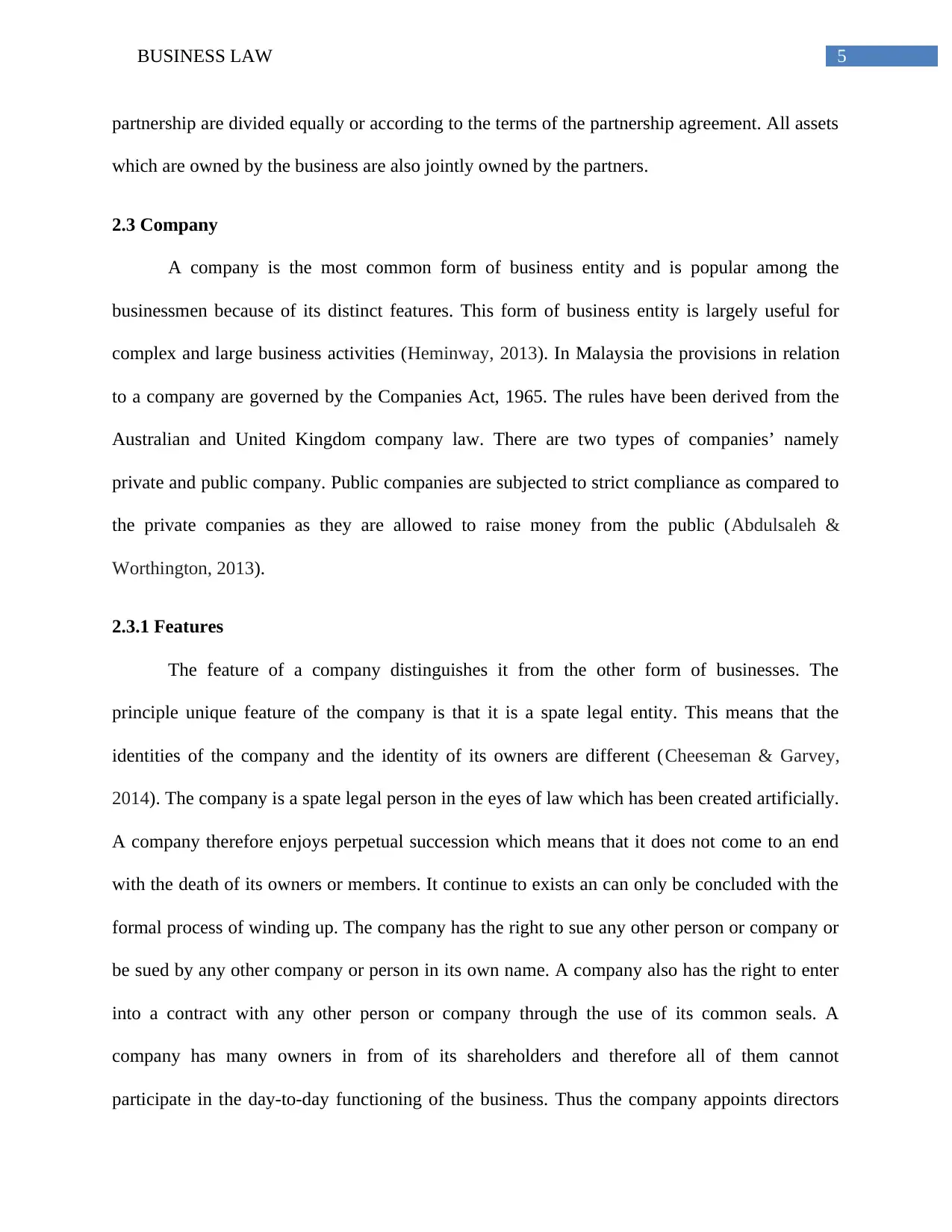
5BUSINESS LAW
partnership are divided equally or according to the terms of the partnership agreement. All assets
which are owned by the business are also jointly owned by the partners.
2.3 Company
A company is the most common form of business entity and is popular among the
businessmen because of its distinct features. This form of business entity is largely useful for
complex and large business activities (Heminway, 2013). In Malaysia the provisions in relation
to a company are governed by the Companies Act, 1965. The rules have been derived from the
Australian and United Kingdom company law. There are two types of companies’ namely
private and public company. Public companies are subjected to strict compliance as compared to
the private companies as they are allowed to raise money from the public (Abdulsaleh &
Worthington, 2013).
2.3.1 Features
The feature of a company distinguishes it from the other form of businesses. The
principle unique feature of the company is that it is a spate legal entity. This means that the
identities of the company and the identity of its owners are different (Cheeseman & Garvey,
2014). The company is a spate legal person in the eyes of law which has been created artificially.
A company therefore enjoys perpetual succession which means that it does not come to an end
with the death of its owners or members. It continue to exists an can only be concluded with the
formal process of winding up. The company has the right to sue any other person or company or
be sued by any other company or person in its own name. A company also has the right to enter
into a contract with any other person or company through the use of its common seals. A
company has many owners in from of its shareholders and therefore all of them cannot
participate in the day-to-day functioning of the business. Thus the company appoints directors
partnership are divided equally or according to the terms of the partnership agreement. All assets
which are owned by the business are also jointly owned by the partners.
2.3 Company
A company is the most common form of business entity and is popular among the
businessmen because of its distinct features. This form of business entity is largely useful for
complex and large business activities (Heminway, 2013). In Malaysia the provisions in relation
to a company are governed by the Companies Act, 1965. The rules have been derived from the
Australian and United Kingdom company law. There are two types of companies’ namely
private and public company. Public companies are subjected to strict compliance as compared to
the private companies as they are allowed to raise money from the public (Abdulsaleh &
Worthington, 2013).
2.3.1 Features
The feature of a company distinguishes it from the other form of businesses. The
principle unique feature of the company is that it is a spate legal entity. This means that the
identities of the company and the identity of its owners are different (Cheeseman & Garvey,
2014). The company is a spate legal person in the eyes of law which has been created artificially.
A company therefore enjoys perpetual succession which means that it does not come to an end
with the death of its owners or members. It continue to exists an can only be concluded with the
formal process of winding up. The company has the right to sue any other person or company or
be sued by any other company or person in its own name. A company also has the right to enter
into a contract with any other person or company through the use of its common seals. A
company has many owners in from of its shareholders and therefore all of them cannot
participate in the day-to-day functioning of the business. Thus the company appoints directors
⊘ This is a preview!⊘
Do you want full access?
Subscribe today to unlock all pages.

Trusted by 1+ million students worldwide
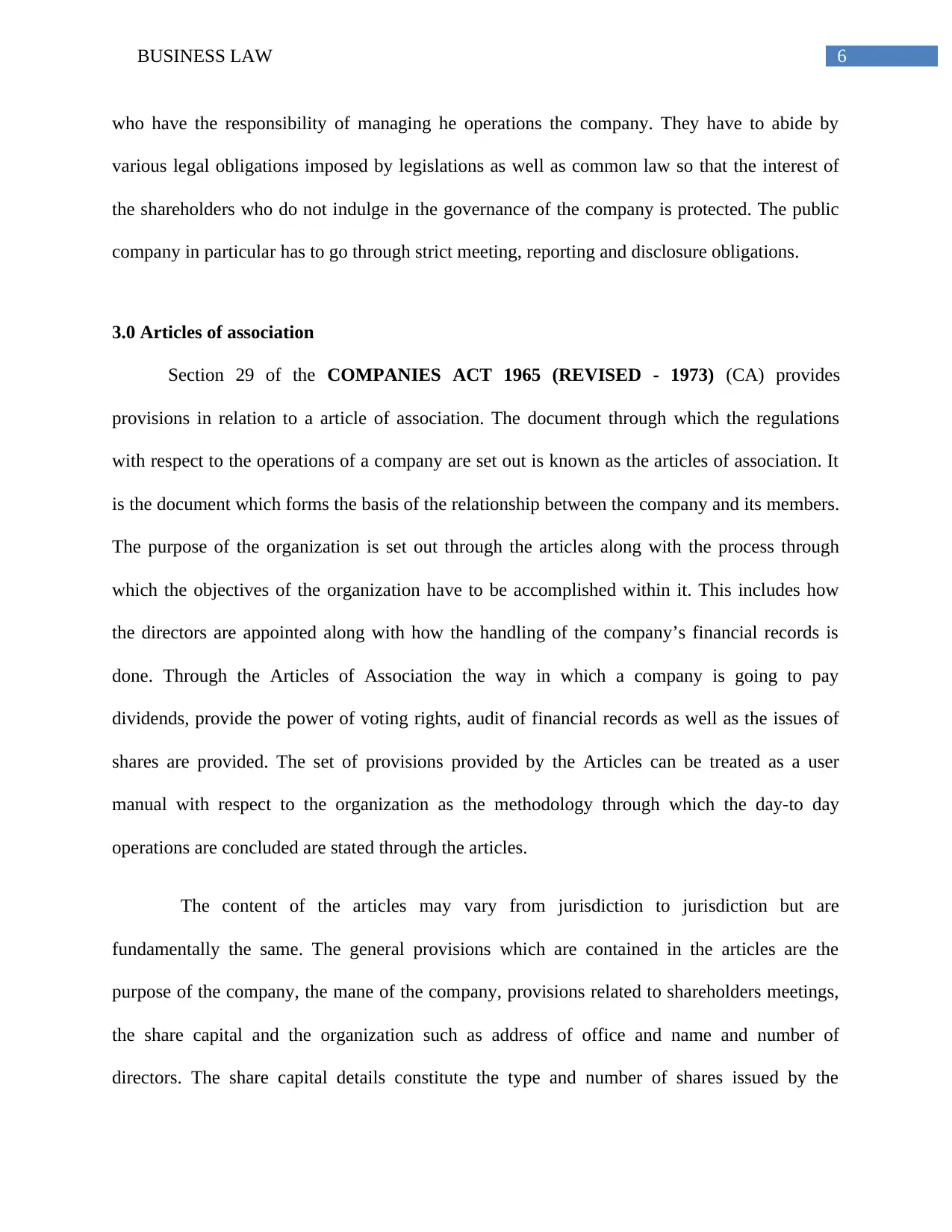
6BUSINESS LAW
who have the responsibility of managing he operations the company. They have to abide by
various legal obligations imposed by legislations as well as common law so that the interest of
the shareholders who do not indulge in the governance of the company is protected. The public
company in particular has to go through strict meeting, reporting and disclosure obligations.
3.0 Articles of association
Section 29 of the COMPANIES ACT 1965 (REVISED - 1973) (CA) provides
provisions in relation to a article of association. The document through which the regulations
with respect to the operations of a company are set out is known as the articles of association. It
is the document which forms the basis of the relationship between the company and its members.
The purpose of the organization is set out through the articles along with the process through
which the objectives of the organization have to be accomplished within it. This includes how
the directors are appointed along with how the handling of the company’s financial records is
done. Through the Articles of Association the way in which a company is going to pay
dividends, provide the power of voting rights, audit of financial records as well as the issues of
shares are provided. The set of provisions provided by the Articles can be treated as a user
manual with respect to the organization as the methodology through which the day-to day
operations are concluded are stated through the articles.
The content of the articles may vary from jurisdiction to jurisdiction but are
fundamentally the same. The general provisions which are contained in the articles are the
purpose of the company, the mane of the company, provisions related to shareholders meetings,
the share capital and the organization such as address of office and name and number of
directors. The share capital details constitute the type and number of shares issued by the
who have the responsibility of managing he operations the company. They have to abide by
various legal obligations imposed by legislations as well as common law so that the interest of
the shareholders who do not indulge in the governance of the company is protected. The public
company in particular has to go through strict meeting, reporting and disclosure obligations.
3.0 Articles of association
Section 29 of the COMPANIES ACT 1965 (REVISED - 1973) (CA) provides
provisions in relation to a article of association. The document through which the regulations
with respect to the operations of a company are set out is known as the articles of association. It
is the document which forms the basis of the relationship between the company and its members.
The purpose of the organization is set out through the articles along with the process through
which the objectives of the organization have to be accomplished within it. This includes how
the directors are appointed along with how the handling of the company’s financial records is
done. Through the Articles of Association the way in which a company is going to pay
dividends, provide the power of voting rights, audit of financial records as well as the issues of
shares are provided. The set of provisions provided by the Articles can be treated as a user
manual with respect to the organization as the methodology through which the day-to day
operations are concluded are stated through the articles.
The content of the articles may vary from jurisdiction to jurisdiction but are
fundamentally the same. The general provisions which are contained in the articles are the
purpose of the company, the mane of the company, provisions related to shareholders meetings,
the share capital and the organization such as address of office and name and number of
directors. The share capital details constitute the type and number of shares issued by the
Paraphrase This Document
Need a fresh take? Get an instant paraphrase of this document with our AI Paraphraser
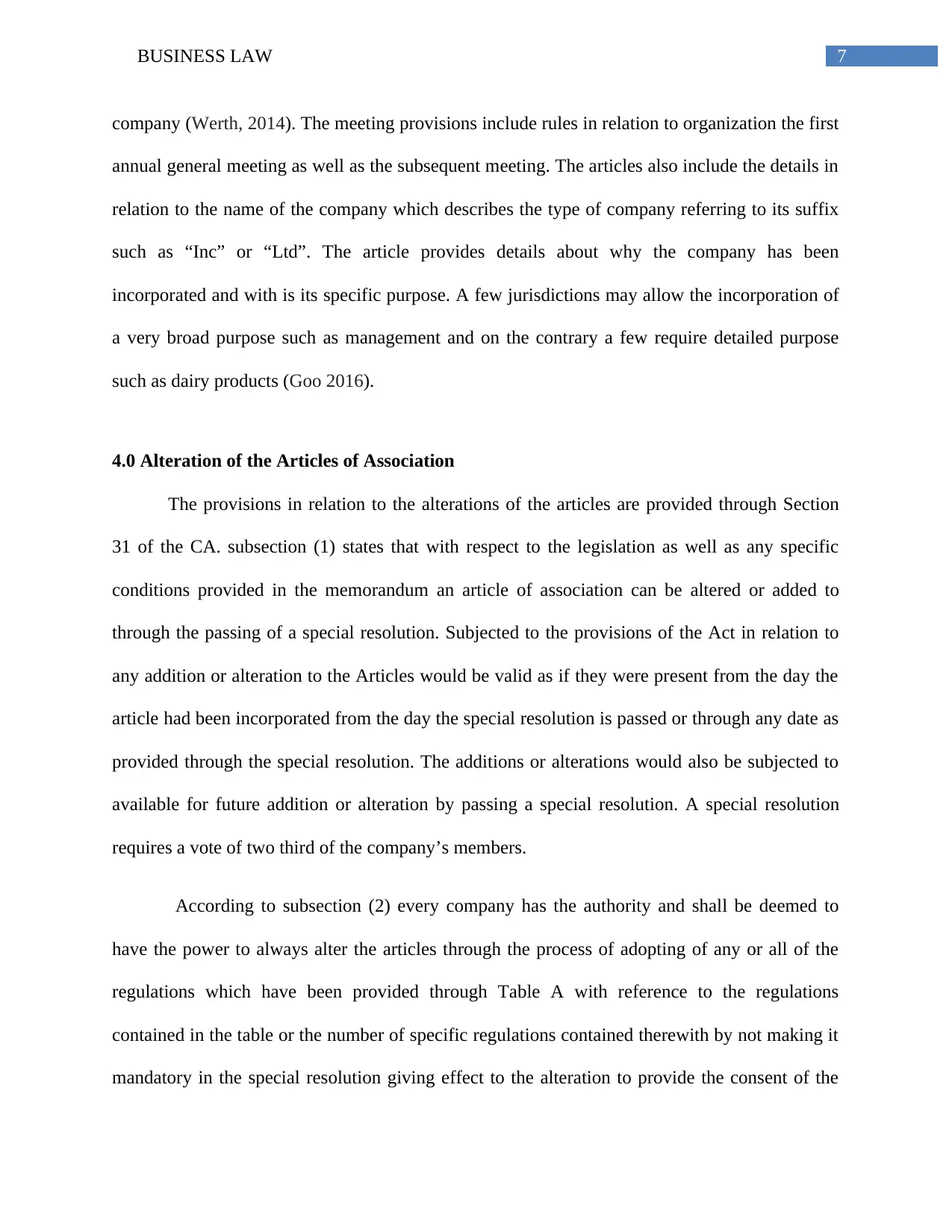
7BUSINESS LAW
company (Werth, 2014). The meeting provisions include rules in relation to organization the first
annual general meeting as well as the subsequent meeting. The articles also include the details in
relation to the name of the company which describes the type of company referring to its suffix
such as “Inc” or “Ltd”. The article provides details about why the company has been
incorporated and with is its specific purpose. A few jurisdictions may allow the incorporation of
a very broad purpose such as management and on the contrary a few require detailed purpose
such as dairy products (Goo 2016).
4.0 Alteration of the Articles of Association
The provisions in relation to the alterations of the articles are provided through Section
31 of the CA. subsection (1) states that with respect to the legislation as well as any specific
conditions provided in the memorandum an article of association can be altered or added to
through the passing of a special resolution. Subjected to the provisions of the Act in relation to
any addition or alteration to the Articles would be valid as if they were present from the day the
article had been incorporated from the day the special resolution is passed or through any date as
provided through the special resolution. The additions or alterations would also be subjected to
available for future addition or alteration by passing a special resolution. A special resolution
requires a vote of two third of the company’s members.
According to subsection (2) every company has the authority and shall be deemed to
have the power to always alter the articles through the process of adopting of any or all of the
regulations which have been provided through Table A with reference to the regulations
contained in the table or the number of specific regulations contained therewith by not making it
mandatory in the special resolution giving effect to the alteration to provide the consent of the
company (Werth, 2014). The meeting provisions include rules in relation to organization the first
annual general meeting as well as the subsequent meeting. The articles also include the details in
relation to the name of the company which describes the type of company referring to its suffix
such as “Inc” or “Ltd”. The article provides details about why the company has been
incorporated and with is its specific purpose. A few jurisdictions may allow the incorporation of
a very broad purpose such as management and on the contrary a few require detailed purpose
such as dairy products (Goo 2016).
4.0 Alteration of the Articles of Association
The provisions in relation to the alterations of the articles are provided through Section
31 of the CA. subsection (1) states that with respect to the legislation as well as any specific
conditions provided in the memorandum an article of association can be altered or added to
through the passing of a special resolution. Subjected to the provisions of the Act in relation to
any addition or alteration to the Articles would be valid as if they were present from the day the
article had been incorporated from the day the special resolution is passed or through any date as
provided through the special resolution. The additions or alterations would also be subjected to
available for future addition or alteration by passing a special resolution. A special resolution
requires a vote of two third of the company’s members.
According to subsection (2) every company has the authority and shall be deemed to
have the power to always alter the articles through the process of adopting of any or all of the
regulations which have been provided through Table A with reference to the regulations
contained in the table or the number of specific regulations contained therewith by not making it
mandatory in the special resolution giving effect to the alteration to provide the consent of the
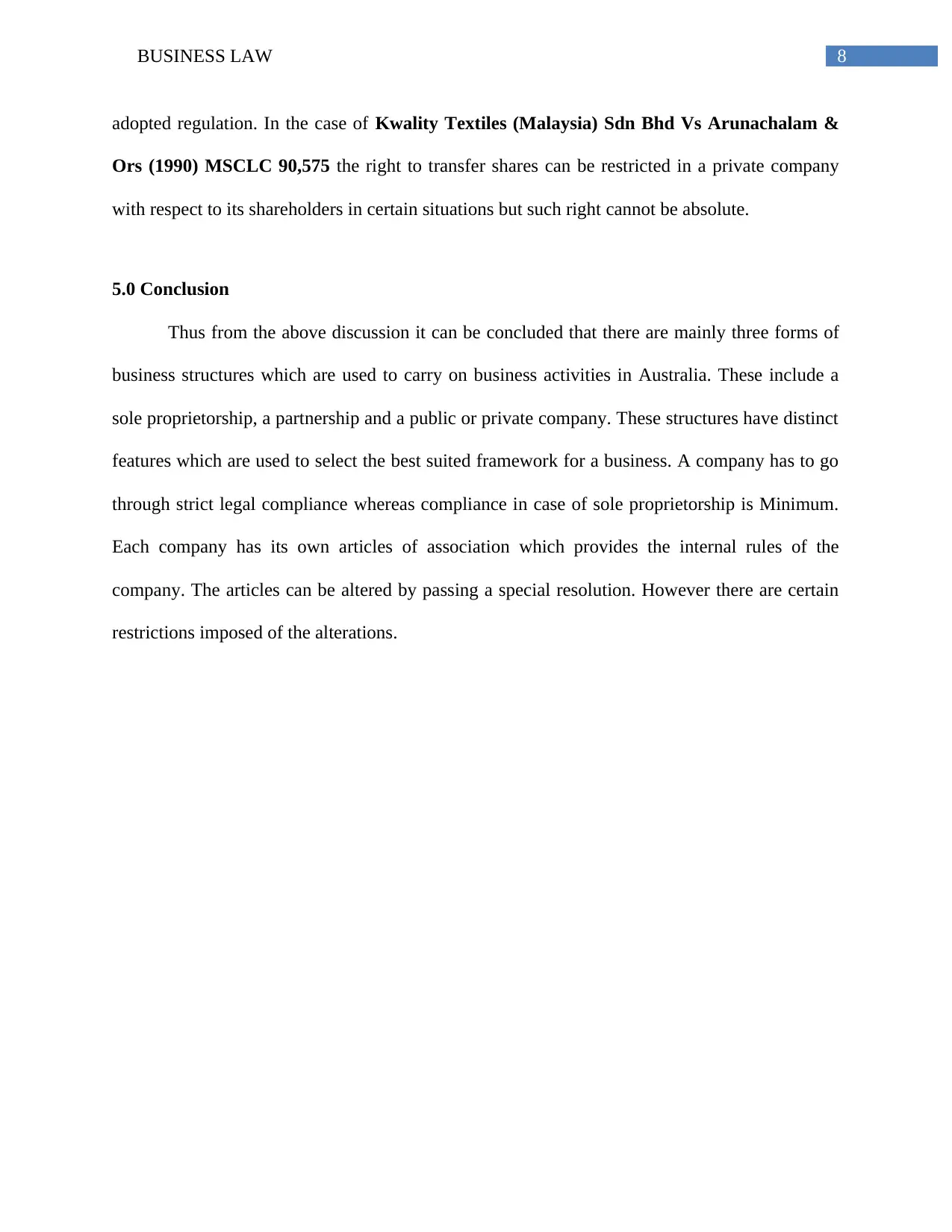
8BUSINESS LAW
adopted regulation. In the case of Kwality Textiles (Malaysia) Sdn Bhd Vs Arunachalam &
Ors (1990) MSCLC 90,575 the right to transfer shares can be restricted in a private company
with respect to its shareholders in certain situations but such right cannot be absolute.
5.0 Conclusion
Thus from the above discussion it can be concluded that there are mainly three forms of
business structures which are used to carry on business activities in Australia. These include a
sole proprietorship, a partnership and a public or private company. These structures have distinct
features which are used to select the best suited framework for a business. A company has to go
through strict legal compliance whereas compliance in case of sole proprietorship is Minimum.
Each company has its own articles of association which provides the internal rules of the
company. The articles can be altered by passing a special resolution. However there are certain
restrictions imposed of the alterations.
adopted regulation. In the case of Kwality Textiles (Malaysia) Sdn Bhd Vs Arunachalam &
Ors (1990) MSCLC 90,575 the right to transfer shares can be restricted in a private company
with respect to its shareholders in certain situations but such right cannot be absolute.
5.0 Conclusion
Thus from the above discussion it can be concluded that there are mainly three forms of
business structures which are used to carry on business activities in Australia. These include a
sole proprietorship, a partnership and a public or private company. These structures have distinct
features which are used to select the best suited framework for a business. A company has to go
through strict legal compliance whereas compliance in case of sole proprietorship is Minimum.
Each company has its own articles of association which provides the internal rules of the
company. The articles can be altered by passing a special resolution. However there are certain
restrictions imposed of the alterations.
⊘ This is a preview!⊘
Do you want full access?
Subscribe today to unlock all pages.

Trusted by 1+ million students worldwide
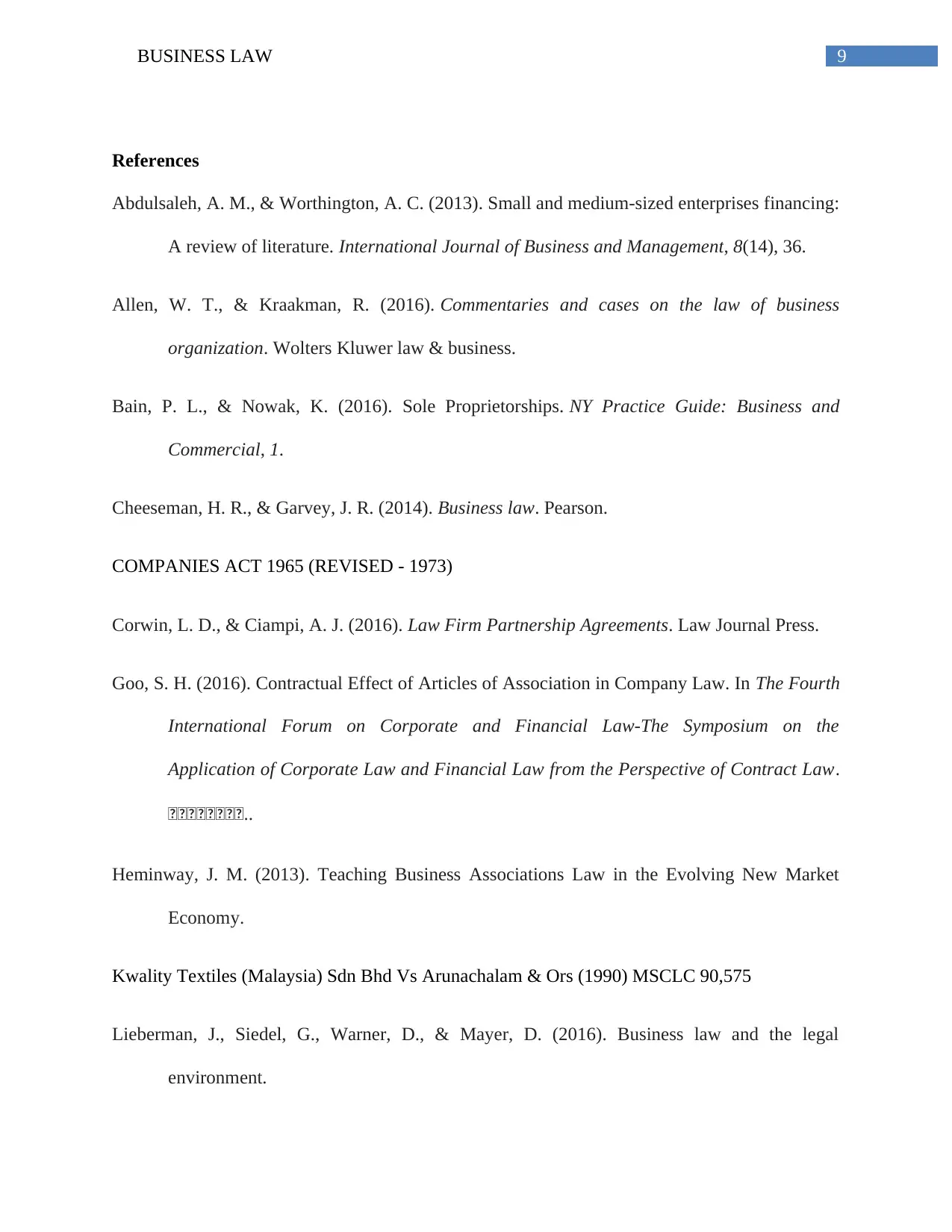
9BUSINESS LAW
References
Abdulsaleh, A. M., & Worthington, A. C. (2013). Small and medium-sized enterprises financing:
A review of literature. International Journal of Business and Management, 8(14), 36.
Allen, W. T., & Kraakman, R. (2016). Commentaries and cases on the law of business
organization. Wolters Kluwer law & business.
Bain, P. L., & Nowak, K. (2016). Sole Proprietorships. NY Practice Guide: Business and
Commercial, 1.
Cheeseman, H. R., & Garvey, J. R. (2014). Business law. Pearson.
COMPANIES ACT 1965 (REVISED - 1973)
Corwin, L. D., & Ciampi, A. J. (2016). Law Firm Partnership Agreements. Law Journal Press.
Goo, S. H. (2016). Contractual Effect of Articles of Association in Company Law. In The Fourth
International Forum on Corporate and Financial Law-The Symposium on the
Application of Corporate Law and Financial Law from the Perspective of Contract Law.
中中中中中中中中..
Heminway, J. M. (2013). Teaching Business Associations Law in the Evolving New Market
Economy.
Kwality Textiles (Malaysia) Sdn Bhd Vs Arunachalam & Ors (1990) MSCLC 90,575
Lieberman, J., Siedel, G., Warner, D., & Mayer, D. (2016). Business law and the legal
environment.
References
Abdulsaleh, A. M., & Worthington, A. C. (2013). Small and medium-sized enterprises financing:
A review of literature. International Journal of Business and Management, 8(14), 36.
Allen, W. T., & Kraakman, R. (2016). Commentaries and cases on the law of business
organization. Wolters Kluwer law & business.
Bain, P. L., & Nowak, K. (2016). Sole Proprietorships. NY Practice Guide: Business and
Commercial, 1.
Cheeseman, H. R., & Garvey, J. R. (2014). Business law. Pearson.
COMPANIES ACT 1965 (REVISED - 1973)
Corwin, L. D., & Ciampi, A. J. (2016). Law Firm Partnership Agreements. Law Journal Press.
Goo, S. H. (2016). Contractual Effect of Articles of Association in Company Law. In The Fourth
International Forum on Corporate and Financial Law-The Symposium on the
Application of Corporate Law and Financial Law from the Perspective of Contract Law.
中中中中中中中中..
Heminway, J. M. (2013). Teaching Business Associations Law in the Evolving New Market
Economy.
Kwality Textiles (Malaysia) Sdn Bhd Vs Arunachalam & Ors (1990) MSCLC 90,575
Lieberman, J., Siedel, G., Warner, D., & Mayer, D. (2016). Business law and the legal
environment.
Paraphrase This Document
Need a fresh take? Get an instant paraphrase of this document with our AI Paraphraser
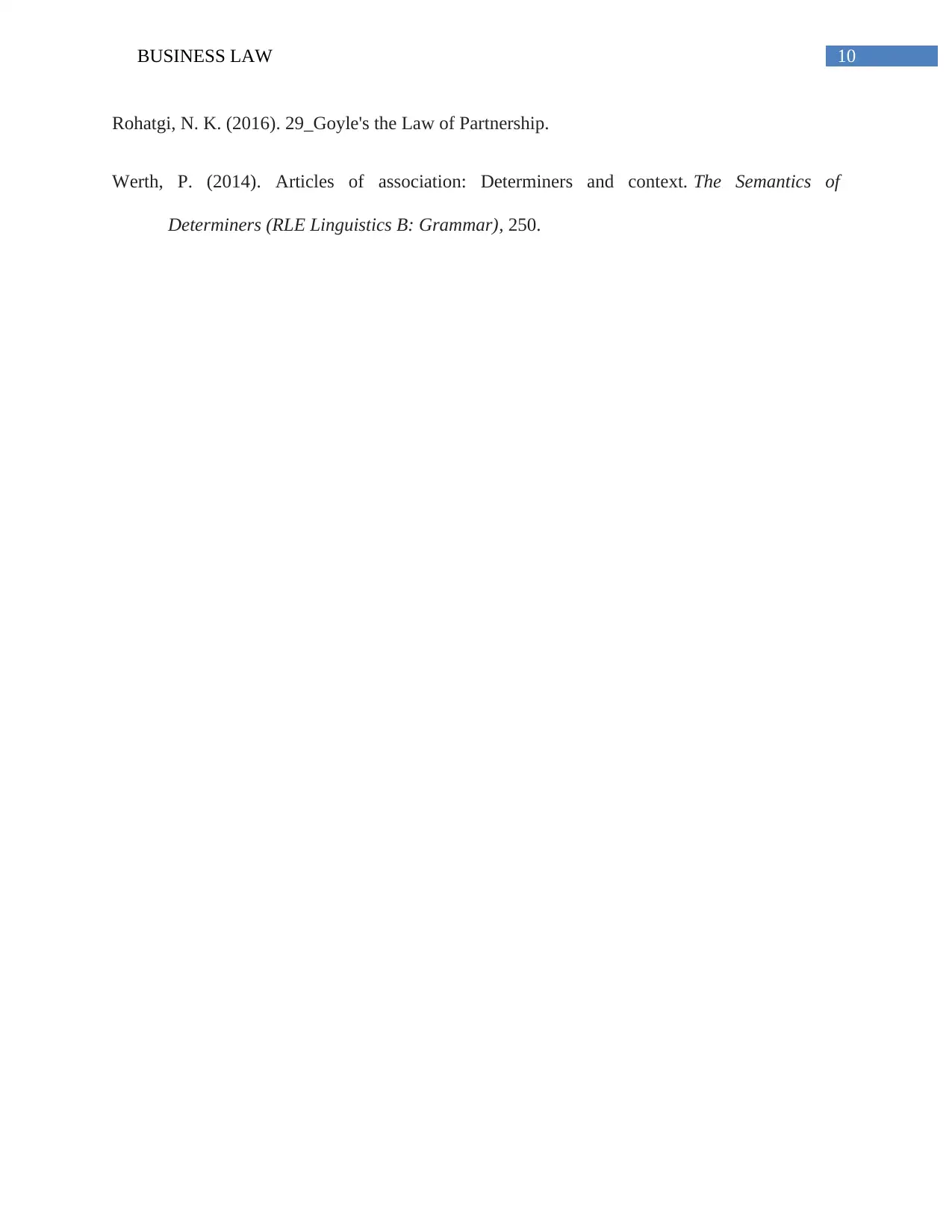
10BUSINESS LAW
Rohatgi, N. K. (2016). 29_Goyle's the Law of Partnership.
Werth, P. (2014). Articles of association: Determiners and context. The Semantics of
Determiners (RLE Linguistics B: Grammar), 250.
Rohatgi, N. K. (2016). 29_Goyle's the Law of Partnership.
Werth, P. (2014). Articles of association: Determiners and context. The Semantics of
Determiners (RLE Linguistics B: Grammar), 250.
1 out of 11
Related Documents
Your All-in-One AI-Powered Toolkit for Academic Success.
+13062052269
info@desklib.com
Available 24*7 on WhatsApp / Email
![[object Object]](/_next/static/media/star-bottom.7253800d.svg)
Unlock your academic potential
Copyright © 2020–2025 A2Z Services. All Rights Reserved. Developed and managed by ZUCOL.





